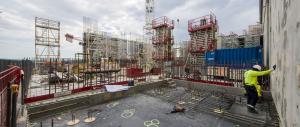Changing views
Twelve years after construction work began on the ITER platform, the installation has acquired its near-final appearance. More than 85 percent of civil works are now completed and—of the 40 buildings and technical areas that the installation comprises—only a few remain to be built.
One of the first things that ITER Council delegates will notice when they meet on Wednesday 15 June, in person for the first time in two years, is how the view from the corridor along the Council chamber has changed. The floor-to-ceiling windows, which used to frame a spectacular view of the heat rejection system's cooling towers, now highlight the future "brain" of the ITER installation—a 3,500-square-metre, three-storey structure that will be home to the 60 to 80 operators, engineers and researchers tasked with "driving" the ITER tokamak and its auxiliary systems.
For the ITER staff and contractors who happen to have an office facing in the same direction, change has been more progressive. For the moment, the works involved in the construction of the two buildings that will host the neutral beam power supply have been performed mostly underground. But on what used to be a large empty lot in front of the Tokamak Complex, structures are now beginning to appear. Ultimately, the familiar view of the crane hall's north facade will be partly hidden by the two buildings—one of them 25 metres tall.
Nondescript in appearance, they will accommodate an array of transformers, generators, rectifiers, inverters and other exotic electrical devices designed to feed 1 MeV ultra high voltage to the neutral injectors for durations of up to one hour—a unique electrical engineering feat.
Over the past few years, as the Tokamak Building crane hall was framed out and eventually delivered in March 2020, the construction of the adjacent Tritium Building seemed to be at a standstill. It was deliberate: in late 2018, following ITER Council approval of the updated project schedule and a staged approach to full power operation, major civil works in the Tritium Building were put on hold in order to focus the workforce on the Tokamak and Diagnostics buildings. A year ago, work resumed and has been progressing ever since, with the aim of being completed in the summer of 2023.
The largest addition to the ITER platform however is yet to come. It will be in the form of a massive 200,000-cubic-metre, five-level structure sitting next to the Tokamak Complex—the Hot Cell Facility. Planning is in progress under the shared responsibility of the ITER Organization (requirements engineering, conceptual design, and the design, procurement, installation and commissioning of process equipment) and the European Domestic Agency (construction and commissioning of civil works and building services).




